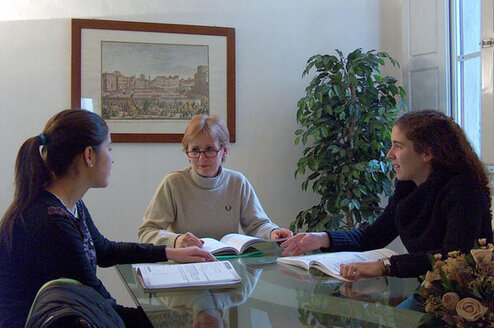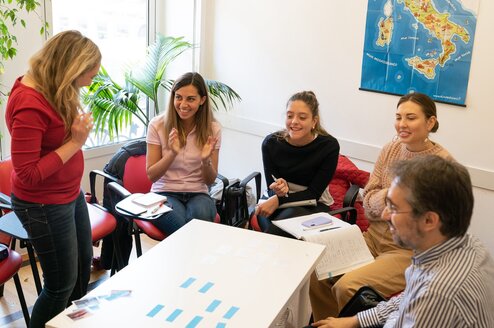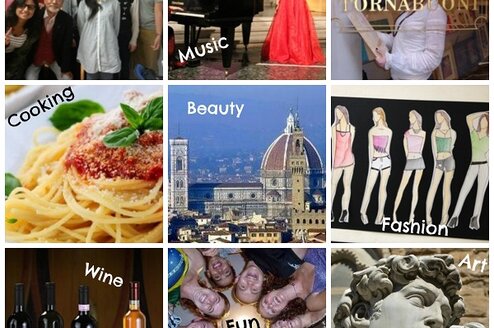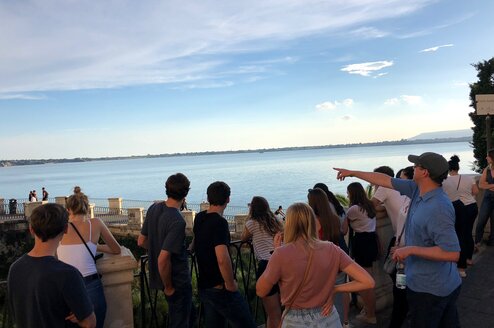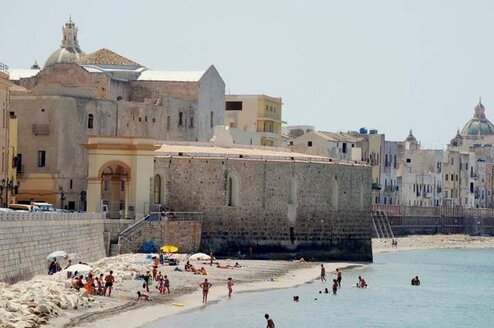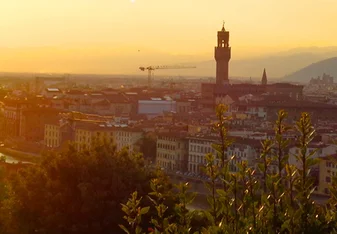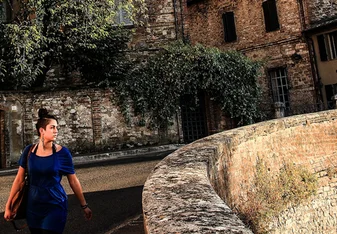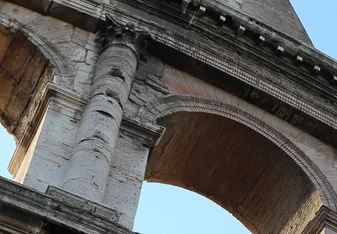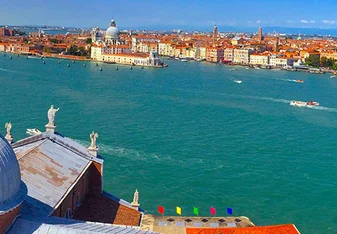Study Abroad Programs in Milan, Italy
Study Abroad Programs in Milan
Pagination
About
With upwards of 180,000 students and seven major universities -- some of which have been considered the best in the world -- it's no surprise that Milan is one of Italy's greatest university cities.
In addition to housing top-tier schools, Milan is a modern and creative city with strong roots in art, design, and international commerce. It's the financial capital of Italy, one of the fashion capitals of the world, and home to many of the world's best-known designers, Fortune 500 companies, and some of history's most influential works of art, like da Vinci's "The Last Supper."
As a study abroad student, you'll have the opportunity to immerse yourself in Italian history and culture and learn in a city that has influenced some of the greatest artists and designers in the world -- all while enjoying all of the pizza, pasta, and gelato you can!
Life & Culture
Culture & Immersion
Studying abroad in Milan will provide endless opportunities to immerse yourself in Italian life and culture through interactions with locals and students during your courses, university activities, and more.
Many study abroad providers include an Italian language learning element or cultural activities as part of their program. Whether it's a cooking course, language exchange, or history lesson, do your best to participate in as many of these activities as possible during your time abroad.
While the number of university courses in Italy that are taught in English is increasing, the majority are still in Italian. Make sure the university you're enrolling in offers courses that you can understand, or brush up on your Italian language skills before enrolling in a university in Italy.
Culture Shock & Support
There's no doubt that moving to a new country can be overwhelming, particularly when simultaneously navigating the challenges of being a study abroad student.
If this is your first time abroad, it's worth exploring programs that offer in-country support. Many third-party providers and universities will assist with everything from your application and visa process, to booking flights and arranging housing, providing pre-departure orientation, and even check in periodically during your time abroad.
While we're positive you'll find Milan to be a beautiful city with friendly, welcoming people, here are a few tips to make your transition into la vita Milanese easier:
- Business Hours: Shops and businesses typically open and close later Italy, and similar to the Spanish siesta, many will close from 12pm or 1pm until 3 or 4pm.
- Greetings: Don't be surprised if you're kissed on the cheek when greeting someone. To avoid bumping noses (or something more awkward) always go to the left cheek first, and then the right.
- Meals: Breakfast is typically coffee and a pastry -- unless you visit a restaurant geared toward tourists, you'll rarely find eggs and sausage on the morning menu. Lunch is the biggest meal of the day and sometimes includes several courses. Italians eat dinner late, sometimes around 8 or 9pm.
- Coffee: If you order un caffè, you'll get an espresso. You'll find that Italians drink their coffee fast, and while standing at the bar. Oh, and don't order a cappuccino (or any milky form of coffee) after a meal or in the afternoon.
Lifestyle
You'll likely find the pace of life in Italy to be quite different than you're used to -- though you'll never suffer from a dull moment in Milan.
Spend your mornings catching up with friends over pastries and espresso, wander through the city's many shops, museums, and galleries, or observe the hustle and bustle of the city from the steps of a historical building. Good stops to begin exploring are Piazza del Duomo, Galleria Vittorio Emanuele II, Museo del Novecento, and the Navigli District.
Many businesses close for a late and extended, but rather large lunch, which is typically shared with family or friends and can consist of a primo (pasta, rice, or other starch), followed by a secondo (a meat, fish, or other protein), and contorno (vegetable dish).
Shops will open up again later in the afternoon and many Italians dress in their finest for a passeggiata, an evening stroll through the streets in the center of town. This is typically followed by stopping for aperitivo or gelato, eventually finishing with dinner sometime after 8pm.
Milan is also known as a city that keeps quite late hours, and nightlife tends to start after 11pm, continuing well into the early morning hours.
Insider Tips on Studying Abroad in Milan
- There are several free walking tour providers in Milan -- this is a great way to get acquainted with the city and learn more about its history, culture, and architecture when first arriving.
- If you want to get away from the busy tourist centers, head out for aperitivo or drinks in more local neighborhoods like Isola, Porta Venezia, or Navigli.
- Milan's outer regions feature several less-crowded and unique museums including Fondazione Prada, Pirelli HangarBiocca, and MUDEC. On the first Sunday of every month, many of Milan's museums -- including Museo del Novecento, Galleria d’Arte Moderna, and MUDEC -- have free admission. While they might be crowded, it's a great way to save a few euros!
- If you book a cheap domestic or international flight, make sure to double check which airport you're flying out of! There are three -- Linate is the closest at about 25 minutes away, while Malpensa and Bergamo (Orio al Serio) are both around an hour out of the city.
Planning Your Trip
Course Types
Milan has long been a hub of fashion, design, and international business in Italy and Europe. Whether you're interested in creating the next designer brand, understanding the architectural greats responsible for the city's treasure trove of historical and modern buildings, or want to learn to climb the corporate ladder at multinational and Fortune 500 companies -- you're guaranteed to find a study abroad program in Milan that suits your interests.
One of the most common ways to enroll in a study abroad program in Milan is through a third-party provider like IES Abroad. Third-party providers typically have relationships with specific universities and help coordinate everything from the application and visa process to providing orientation and in-country support during your time abroad.
It's also possible to study in Milan through direct enrollment or exchange. While this option can be more flexible and might save you a bit in program fees, you'll likely need to handle more of the logistics on your own. Don't forget to make sure that your course credits from Milan will transfer back to your home university!
Housing
Check with your program provider to see if accommodation is included in your program costs or organized for you. Either way, there are several different options for housing during your study abroad in Milan -- homestays, hostels, student housing, and independent living in an apartment.
Homestays are a great opportunity for cultural immersion and learning Italian. You'll have the chance to live with a local family, share meals, and gain a deeper understanding of local life. Alternatively, student housing and hostels are often more affordable options than living on your own and will allow you to build friendships and interact with both local and international students.
If you're more independent and wish to live alone, there's always the option of renting an apartment in the city, though this will likely be the most expensive choice.
Transportation
Milan is the second largest city in Italy and has several international airports and train stations, making it very well connected to other areas of Italy, as well as the rest of Europe. Additionally, the inner city is connected by subway, bus, and tram lines.
Tickets for most of Milan's transportation can be purchased at newsstands and ATM points around the city, and it's incredibly affordable. If you're under 26, a monthly pass will cost just €22, and €35 if you're over 26.
All public transportation in Milan is operated by the same company, the Azienda Trasporti Milanesi (ATM). In other words, if you see "ATM" on a sign in the city, it's likely not directing you to a cash machine, but rather a ticket counter.
Ticket inspectors dressed in casual clothing are very common across Italy so always make sure to validate your ticket and keep it on hand in case you're asked for it.
Milan also has a bike sharing service called BikeMi, with over 100 stations around the city and weekly passes for just €6.
Costs & Funding
Cost of Living
When budgeting for study abroad, it's important to know what is included in your program costs -- some will include housing and some meals, while others will only cover tuition. As a study abroad student in Milan, your biggest expenses will likely be tuition and flights. Don't worry! There are plenty of scholarships and grants available to help you cover this portion of your study abroad costs.
If you do need to find housing, living with other students in a shared space will likely be the most affordable option. A single bedroom apartment in Milan can cost upwards of 900 euros per month, whereas you can find shared student accommodation for several hundred euros per month.
It's very much possible to lead a comfortable and fun lifestyle in Milan without breaking the bank. Though it's tempting to indulge in pizza, pasta, and gelato every day, try not to eat out all the time and cook at home instead. Do your shopping at local markets -- Mercarto Viale Papiniano and Mercato Rionale Fauché are slightly larger and more popular markets, though nearly every neighborhood in the city will have its own smaller version.
That being said, it's not difficult to wine and dine in Italy on a budget. A coffee and pastry for breakfast shouldn't cost more than a few euros, a paninoi around €5, and a slice of pizza for €2. Lunch or dinner at an inexpensive restaurant will cost €12-20, but a glass of house wine can sometimes be found for €2 or less! Try your hand at cooking Italian at home, and definitely get acquainted with aperitivo.
Visas
Visa requirements for students in Italy vary depending on the length of your stay and country of citizenship. If you're from an EU country you will not need a visa to work or study in Italy, however, it is recommended that you register with the Registry Office of the Municipality of Milan for stays longer than 90 days.
If you are not from an EU country and enroll in a course that's less than 90 days, you can take stay in Italy on a Schengen visa. For courses longer than 90 days, you will need to apply for a Residence Permit for study purposes (issued at most police stations) within eight days of your arrival in Italy.
The process and requirements for non-resident students in Italy differ depending on country of citizenship, so it's best to contact the nearest Italian consulate directly to learn more about the steps you need to take.
Keep in mind that Italian bureaucracy can be notoriously slow, so it's best to start this process as soon as you've been accepted into a study abroad program in Italy.
Can You Work While Studying Abroad in Milan?
Non-EU-students can work during their studies in Milan if they obtain a work permit. That being said, the process of doing so can be quite lengthy (expect at least two months), so it's best not to rely on working during your time as a study abroad student in Milan.
Regardless of whether you work in Italy or not, you will need to be issued a "codice fiscale" in order to complete tasks like opening a bank account, signing a rental or utilities contract, or registering with the national health service. This can be done at the local tax office, though many universities have their own procedure for foreign students.
Scholarships
Don't let designer duds and bottomless bowls of pasta (oh, and don't forget about tuition) break the bank during your time abroad in Milan -- there are plenty of scholarships available to assist with the cost of studying:
- IES Abroad offers a variety of scholarships for those participating in their programs -- including a few great options around Italy!
- As a non-profit, the various USAC study abroad scholarship opportunities aim for students to gain international experience without breaking the bank.
- If you're a U.S. citizen of Italian descent, the Order Sons of Italy in America might sponsor your study abroad program in Italy.
- Many universities in Milan offer scholarships for non-resident students, including Politecnico di Milano and Università Cattolica del Sacro Cuore.
- More Study Abroad Grants and Scholarships














